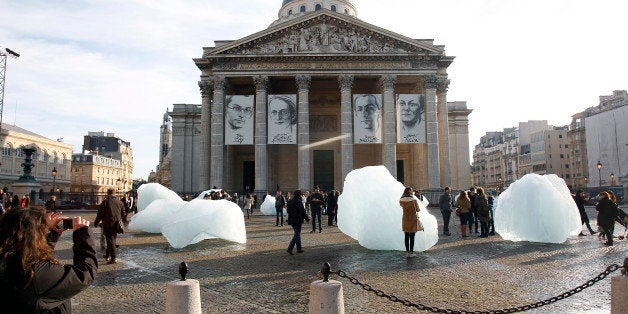
World leaders, environment experts and delegates from around the globe are convening in Paris for COP21, the U.N.'s climate summit. Meanwhile, in the center of the city at Place du Panthéon, the public has the chance to encounter Ice Watch, a work by acclaimed artist Olafur Eliasson and scientist Minik Rosing, supported by Bloomberg Philanthropies.
Ice Watch consists of 80 tons of free-floating blocks of ice from Greenland, arranged in a clock formation. Remaining in the public square the ice melts, visually representing the climate change taking place on our planet. In a release about the art work, Eliasson said, "Art has the ability to change our perceptions and perspectives on the world, and Ice Watch makes the climate challenges we are facing tangible."
This is one of many works in which Eliasson explores form and materials while also addressing some of the world's most pressing problems. In 2012, together with solar engineer Frederik Ottesen, Eliasson designed and launched Little Sun, a social enterprise that produces and distributes solar-powered LED lights for the nearly one quarter of the world's population that do not have access to electricity. During COP21, he will be using the outdoor installation as a means to spur climate action.
Eliasson's work, along with many of his creative colleagues, is generating renewed interest in public art. One reason for this is access to advanced technologies. New materials -- some also embraced by architects -- are enabling artists to experiment with scale and shape, making work that is durable, expressive and resilient in outdoor conditions. And social media invites people to get involved in the dialogue on outdoor sculpture like never before.
These new conditions for amplified impact are combining with increased public interest in the built environment of cities. Bloomberg Philanthropies recently launched the Public Art Challenge to support temporary public art in U.S. cities through strong partnerships between artists, arts organizations and local government. The goal is to engage communities and catalyze economic development by showcasing creative imagination, and positioning artists as important resources for addressing urban issues. The response -- applications from 237 cities representing 68 million U.S. citizens in 45 states -- suggests that public art is increasingly able to represent urban aspirations.
While art can make a powerful impression when seen in the context of a museum or gallery, showing work in a public space can reach new and unexpected audiences. Under the Bloomberg Administration, New York City hosted nearly 500 temporary art projects. These projects ranged dramatically in scale and nature and each one was unique in its own way -- but the one constant was the impact it had on communities. Public art reframes the familiar and reintroduces its viewers to places they think they know. There is no right or wrong response, and it's hard to encounter such a reorganization of familiar space and not walk away with your perception adjusted and enlarged.
This embrace of interpretation and participation offers a rare kind of shared civic experience. While no two people see a public art installation in quite the same way, each reaction can forge a sense of connection across the invisible boundaries that often separate citizens. By encouraging people with multiple points of view to experience something together, public art can become a valuable force for social cohesion, affirming both individual and collective responses.
While the conversations indoors among world leaders during COP21 will impact how international bodies address climate change, Ice Watch will bring those conversations to the general public. And by encouraging open dialogue, Eliasson's work will add a meaningful layer of opportunity and insight to the complex dynamics of consensus-building. With the resonance unique to public art, Ice Watch offers the opportunity to activate different parts of the civic landscape, spurring insight and cultivating community awareness about an urgent set of issues.
Patricia E. Harris is the Chief Executive Officer of Bloomberg Philanthropies, a data-driven foundation that encompasses all of founder Michael R. Bloomberg's charitable giving. As CEO, Harris works across five key program areas -- arts, education, environment, government innovation, and public health -- to help ensure better, longer lives for the greatest number of people. By developing, supporting, and incubating initiatives, Bloomberg Philanthropies is improving lives across the nation and the world. Previously, Harris served as the First Deputy Mayor of the City of New York. She is the first woman in New York City's history to have served in this role, which is the City's highest appointed position.